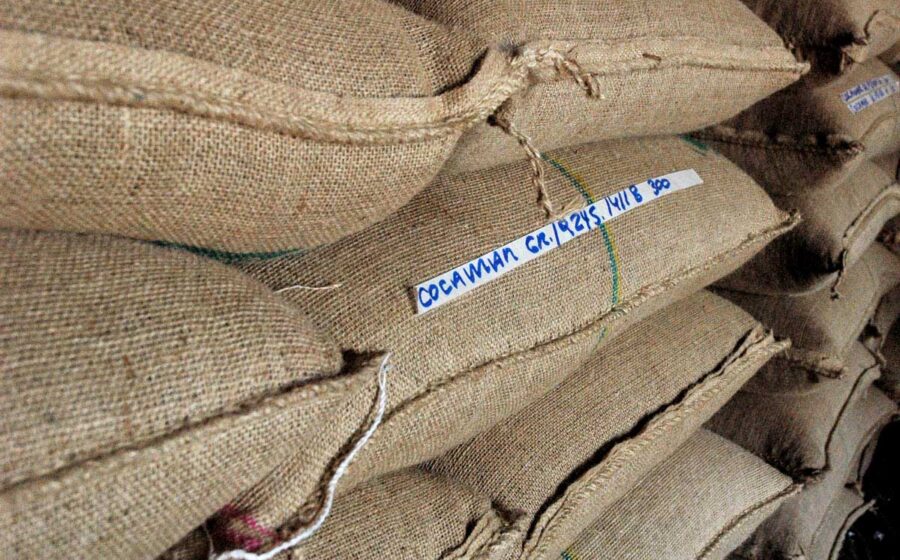[S]omehow the bean of the coffee cherry makes its way from the farmer’s hands to our roasteries, cafés, and customers’ cups, going all that way without going bad. In spite of a lack of knowledge of the process, coffee storage is one of the most important aspects of the journey every bean makes on its way to barista competitions and busy shops. There’s a mystery to each sealed container of coffee, and we in coffee consuming countries deal with the ramifications of un-ideal coffee storage in producing countries every day, rejecting lots because they are “baggy” or present mold and other taints on the cupping table. Why, exactly, does the coffee taste that way when the pre-ship sample was clean? Ian Fretheim, director of sensory analysis for Café Imports in Minneapolis, says it’s all about water: at the farm level, during shipping, and on through to roasting.
In spite of a lack of knowledge of the process, coffee storage is one of the most important aspects of the journey every bean makes on its way to barista competitions and busy shops.
“Coffee storage begins at origin, with processing,” he says. “Coffee is kind of like a sponge: it will suck up moisture from moist air, or release its moisture into dry air.” He adds that two water-related factors determine much of the ultimate taste of the delivered coffee: moisture content and water activity, though the latter has only recently been approached as a research topic in the industry. All seeds are dried before shipping. The process brings the seed’s life to a standstill and ensures it doesn’t sprout during shipment. The drying process, however, reduces the organic content of the seed, essential for flavor development during roasting, so over-drying can be death’s kiss to cup quality. Green coffee tends to start around forty-percent moisture content, and is dried at origin before being bagged and shipped. The generally-recommended “sweet spot” of eleven- to twelve-percent moisture in green coffee puts the kibosh on microbial activity, lipid oxidation, mold, and other processes during shipment, though it’s a moving target: any rise in moisture content, and those processes start up again, undetected in the bowels of a freighter on the Pacific or Atlantic oceans.
Moisture content is measured multiple times during coffee’s travels using often-expensive meters or, as coffee consultant Rob Hoos explains, the tooth test. “When the green coffee cracks or breaks between your teeth it is likely too dry. If it gives underneath your teeth or is malleable then it is likely too wet,” he says. “But I learned from farmers in Guatemala, if it is firm, doesn’t shatter or give-way (at least any more than the tiniest bit) then it is likely within the desirable moisture content.”
Water activity is a factor with much less data and much more mystery attached. “Water activity is basically how tightly bound the moisture is chemically to the other stuff in coffee,” says Fretheim. For example, he says, if you compare a glass of water and a glass of water with, say, sugar dissolved in it, the water activity in the solution will be slightly lower than the pure water due to its molecules being bound with the solute. To accept microbes, molds, and other negative influences, the water needs to be available for them to proliferate. He adds that though distinct, water activity and moisture content tend to follow each other, and if a coffee is around eleven-percent moisture, water activity will generally be at an acceptable level.
Once the ideal moisture levels are reached, they must be maintained. K.C. O’Keefe, owner of Café Verde in Lima and one of Peru’s foremost coffee brokers, says, “We don’t have to prevent moisture transfer just once, but continually, so it doesn’t fluctuate. There are some theories that the evaporation process results in loss of soluble materials, so in the end coffee that has been dried and re-wetted is proven to have less intense flavor and age faster.” He adds that, given the processing practices in Peru and Honduras (this drying and re-wetting process), both countries have many aging issues in consuming countries, with coffees occasionally tasting like cardboard shortly after shipment, while a Kenyan coffee, for example, will last twelve to eighteen months before hitting that point.
How does processing affect moisture content? There are several typical methods for drying coffee, depending on the region, the equipment and infrastructure owned by the producer, and other factors. The first, and most widespread, is to spread the coffee on tarps on the ground, rooftops, and roadsides. “You definitely have trucks driving over your Sumatran coffee,” says Fretheim. More advanced methods include laying the coffee on patios where the coffee is stirred to facilitate even drying, using parabolic dryers (raised beds under tents), and mechanical dryers. There are inherent pitfalls in each method, and each country and even farm varies in its typical practices.
Parabolic dryers can work well, if they are positioned correctly—so air moves through or there are fans to circulate fresh air—but they can create humid mini-climates that inhibit drying, which prompts farmers to resolve the bottleneck by throwing the coffee into bags partially dried or toss it into mechanical dryers to finish it off. Coffee grown in cloud forests takes longer than the recommended fourteen days to dry, and mold and other undesirables can grow. On the other hand, drying too fast creates problems in the cup. Brian Speckman, vice president of InterAmerican Coffee, says, “The sun in Africa is so intense that, with raised beds and good airflow, the coffee dries too fast, in nine or ten days, which can crack the parchment and lead to staling and faded cups. Mechanical dryers can be set too hot, which creates the same problem.”
Once the coffee is processed, it must be bagged, and bag choice matters to ultimate cup quality because of its interaction with water activity. O’Keefe says, “Most farmers are taught to store in burlap bags, which is probably sound advice if the coffee’s wet and needs to breathe, but not when it’s been dried to twelve percent. Then, you need to put it into a sealed container so it won’t take on moisture from its surroundings.” For producers, often in remote areas and taking loans against their next crop to make it through the season, other bag options can be impossible. O’Keefe says he’s seen a lot of success in Bolivia and Panama when producers used cheap black trash bags for the dried coffee, sealed with duct or packaging tape.
Roasters with strong relationships with their importers and farmer partners can often request specific bags be used for their coffees. Bag options include the popular GrainPro, and imitators such as Ecotact, which O’Keefe purchases in Lima and sends to his farmer partners at a cost as low as three cents per pound of coffee. These plastic bags are a huge step forward because they prevent outside moisture and other substances from traveling in and affecting the coffee. While these bags don’t have universal buy-in from the industry, GrainPro is a step forward from jute bags, and cost-effective. Other options include polypropylene bags, which resemble dog food bags, such as the Innovation Bag developed by Bourbon Specialty Coffee; double-lined kraft bags complete with one-way valves (not very practical for standard-size lots); and cotton bags within jute.
William Boot, of Boot Coffee Consulting., says that his father began experimenting with cotton bag liners many years ago, and has seen great results. “Cotton acts as a membrane to allow the coffee to gradually release moisture and carbon dioxide, while also creating a barrier for moisture from without.” As for other options, O’Keefe says that George Howell has had good luck with freezing lots of coffee in vacuum-sealed bags. “I tried a four-year-old Kenyan from him which scored ninety-one on the table,” he says. “Convinced me.”
Processed and bagged coffee must still be shipped, and here things get dicey. Fretheim explains it this way: “Pack up your coffee—hopefully you did everything right up to that point—and then put it in a big huge box and take it down to sea level somewhere near the equator in the sun and humidity.” The danger is in cooking the coffee, or reactivating the life of the seed through increased moisture levels. Shipping containers are notorious for causing temperature fluctuation and thus condensation issues. Coffees near the outside get baked in the sun, and might be delayed in customs or a port layover for days or even weeks. The skin of the container will reach 100 degrees Fahrenheit at times, or the container may spring a leak just before a tropical storm.
O’Keefe has performed informal experiments, many with long-time partner Intelligentsia. Thinking about temperature stability, he packed a container’s first row, floor, and ceiling with commodity-grade coffee, and cocooned the microlots in the center, and he believes this contributed to better stability in the moisture level of the coffee. Certain buyers have insisted on having the coffee shipped in refrigerated containers maintained at forty to fifty degrees Fahrenheit, though the practice raises environmental issues.
It’s kind of a magical thing when you get that great coffee where everything happened all the way through and it tastes like your pre-ship sample. But I don’t know, it’s a little entitled or shortsighted to think we should have that every time.
Getting the coffee quickly into port isn’t the whole feat. Speckman points to the strikes on the West Coast as an example. “We have so many shipping issues now that are causing the coffees to suffer,” he says. “Shipping options have been reduced. Now, a couple of the routes from Colombia sit in the sun in the Bahamas for four to seven days.” And, though a strike in Oakland was resolved this spring, dock workers are in low supply, resulting in bottlenecks everywhere: massive bales of shipping containers sitting for weeks, trucks that could haul three containers a day now getting only one, and prices rising. For O’Keefe, it’s even more complicated: “We happen to be a cocaine-producing country, and the USDA stabs about ten percent of the bags coming in from Peru. We have to beg them, ‘Please no hooks,’ and send duct tape along with a request for resealing.” Hooks are often used to pull the coffee from the container, and a pleading note is all an exporter can do.
With all these (and many more) variables affecting the ultimate quality of coffee, roasters need to be realistic. For coffees coming from an importer, any lots that didn’t stand up to the samples the importer tasted are taken care of before the roasters taste them. Coffees purchased through direct trade, though, can sometimes not match their samples. Fretheim says, “It’s kind of a magical thing when you get that great coffee where everything happened all the way through and it tastes like your pre-ship sample. But I don’t know, it’s a little entitled or shortsighted to think we should have that every time.”
Use best practices in storing coffee before roasting to complete the quality circle. If the coffee comes in plastic, tie the bag after opening to maintain moisture levels, and make sure the bags don’t get wet or take on taints from products nearby. Boot recommends controlling relative humidity to forty to sixty percent and says that lower temperatures are better, thirty-five to fifty degrees Fahrenheit. In addition, circulate the air four to six times an hour, and if building a coffee humidor, use chemical-free particle board for construction.
Fretheim says about coffee storage, a little sadly, “It’s all the little best practices. There’s no magic bullet.”
—Emily McIntyre is a regular contributor to Fresh Cup, and the co-owner of Catalyst Coffee Consulting.











